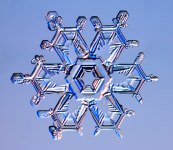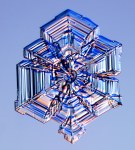|
|
Myths and Nonsense
... Fact and Fancy in the world of ice and snow ... |
|
|
| 1. What do you
think of the work of Masaru Emoto?
2. Snow crystals are so perfectly
symmetrical! ... Are there not some special forces at work that
ensure this perfection?
3. Is it true that when a
snowflake melts and refreezes, it ends up with the same shape it had
before? |
|
The Hidden Messages in Water |
What
do you think of the work of Masaru Emoto?
 If you haven't heard of Mr. Emoto,
he has published several books claiming that ice crystals grow
differently when water is first exposed to different thoughts and
feelings. For example, he may start by playing assorted varieties
of music -- jazz, classical, rock-and-roll, etc. -- to different
containers of water. The music is then turned off and the
"treated" water is used to grow snow
crystals. He claims that the
different musical treatments yield different types of snow crystals, and
shows us pictures of the results to prove his case. If you haven't heard of Mr. Emoto,
he has published several books claiming that ice crystals grow
differently when water is first exposed to different thoughts and
feelings. For example, he may start by playing assorted varieties
of music -- jazz, classical, rock-and-roll, etc. -- to different
containers of water. The music is then turned off and the
"treated" water is used to grow snow
crystals. He claims that the
different musical treatments yield different types of snow crystals, and
shows us pictures of the results to prove his case.
If you think it defies
common sense that water does this, you are right. In fact water
does not respond to thoughts and feelings - it's just water.
How then does one explain Mr. Emoto's experiments? My best guess
is that Mr. Emoto grows hundreds of crystals and then selects different
shapes to demonstrate whatever point he wishes to make. For
example, when the water was exposed to classical music he picks out some
beautiful crystals to show us. For rock-and-roll, he selects some
ugly crystals and shows us those. He then concludes that classical
music makes beautiful crystals while rock-and-roll makes ugly ones.
What he does not show us is that both musical treatments made the same
numbers of beautiful and ugly crystals. The "treatments" actually
had no effect.
Do I know Mr. Emoto does this? No, which is
why I called it a guess. Mr. Emoto has never published his work in
a reputable scientific forum, where it would be scrutinized. He
only presents it in self-published books, where he is free to say
whatever he wants. Basic physics says the work cannot be correct,
and Mr. Emoto has not convinced the scientific community that his
experiments have any merit whatsoever.
Have I tried to reproduce Mr. Emoto's experiments? No,
and I don't intend to. While I try to keep an open mind to new
ideas, this one is just too outrageous. I only have limited time
and resources, so I study ideas that I think are more likely to be
fruitful. As we liked to say back on the farm in North Dakota --
it's good to have an open mind, but not so open that your brains fall
out!
|
|
Snowflake Perfection |
Snow
crystals are so perfectly symmetrical! ... Are there not some
special forces at work that ensure this perfection?
 People are sometimes convinced
that the
simple explanation of snowflake symmetry cannot be correct, because
snow crystals are too perfect in form. These folks argue that the
simple explanation would likely yield less ideal shapes, less perfect
six-fold symmetry. Therefore they suspect something else is
happening -- perhaps some acoustical or quantum mechanical oscillations
are enforcing symmetrical growth. People are sometimes convinced
that the
simple explanation of snowflake symmetry cannot be correct, because
snow crystals are too perfect in form. These folks argue that the
simple explanation would likely yield less ideal shapes, less perfect
six-fold symmetry. Therefore they suspect something else is
happening -- perhaps some acoustical or quantum mechanical oscillations
are enforcing symmetrical growth.
The flaw in this reasoning is the statement that snow crystals are all
extremely symmetrical. You can disprove this for yourself if you
simply go outside and take a close look at some falling snow. You
will soon realize that the beautifully symmetrical specimens are hard to
find! The rather unattractive irregular crystals are by far the
most common variety (see the
Guide to Snowflakes under the heading of Irregular Crystals
for some pictures). Even on the best of days, I search for hours
to find just a few beautifully symmetrical
 specimens. I
typically glance over thousands of crystals on my collection board
before selecting one to photograph, and the pictures you see in the
Galleries are some of the best among over 7000 pictures I've taken. specimens. I
typically glance over thousands of crystals on my collection board
before selecting one to photograph, and the pictures you see in the
Galleries are some of the best among over 7000 pictures I've taken.
Alas, the
vast majority of snow crystals are not even close to perfectly
symmetrical. The simple mechanism does indeed produce much imperfect symmetry, as you would expect.
I always select their most symmetrical crystals to display
... after all, not many people are interested in looking at
the irregular ones! |
|
Repeating Snowflakes |
Is it true
that when a snowflake melts and refreezes, it ends up with the same
shape it had before?
Nope; not even close.
That's just a tall tale that's been circulating around for many years.
Here again, water does not have any memory. It's just water. |
|
|
